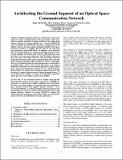| dc.contributor.author | Del Portillo Barrios, Inigo | |
| dc.contributor.author | Sanchez Net, Marc | |
| dc.contributor.author | Cameron, Bruce Gregory | |
| dc.contributor.author | Crawley, Edward F | |
| dc.date.accessioned | 2016-11-21T15:15:50Z | |
| dc.date.available | 2016-11-21T15:15:50Z | |
| dc.date.issued | 2016-03 | |
| dc.identifier.isbn | 978-1-4673-7676-1 | |
| dc.identifier.uri | http://hdl.handle.net/1721.1/105374 | |
| dc.description.abstract | Optical communications are envisioned as a key technology for space communication in the near future. This transition to optical terminals is being pushed by the higher data volume demand of certain missions (i.e.: missions DESDyNI (now cancelled) and NISAR had together a requirement of 60 Tb/day, whereas the data-volume transmitted daily by the Space Network nowadays is roughly 40 Tb) and by the spectrum encroachment in current RF bands. In addition, recent missions like LLCD and OPALS have demonstrated that optical systems present multiple advantages with respect to RF terminals, such as their lower mass, size and power and the higher data-rate they offer (up to 10 Gbps). However, one of the main issues of using optical systems is the space-to-ground link, due to the difficulty of penetrating through atmospheric clouds. Geographic diversity of ground stations has been proposed as an alternative to mitigate these effects. The goal of this paper is to analyze different architectures for the ground segment of a fully optical space relay-communications network to serve LEO missions. In particular, we analyze the tradespace characterized by the decisions 1) number and location of optical ground stations, 2) use of GEO relay satellites vs. direct to Earth (DTE) approach and 3) presence of crosslinks among relay satellites. To that end, we use historical NOAA's weather data and the cloud fraction dataset from Aqua's and Terra's MODIS instruments to characterize weather conditions across the globe. We later use these models to determine the best locations to place ground stations that support optical terminals. Next, we present ONGSA, a network simulator that incorporates the cloud models in order to simulate end-to-end operations of the optical network. Finally we exercise ONGSA to explore the aforementioned tradespace and analyze both cost and performance (in terms of availability) for each architecture. | en_US |
| dc.description.sponsorship | Fundación Obra Social de La Caixa | en_US |
| dc.language.iso | en_US | |
| dc.publisher | Institute of Electrical and Electronics Engineers (IEEE) | en_US |
| dc.relation.isversionof | http://dx.doi.org/10.1109/AERO.2016.7500803 | en_US |
| dc.rights | Creative Commons Attribution-Noncommercial-Share Alike | en_US |
| dc.rights.uri | http://creativecommons.org/licenses/by-nc-sa/4.0/ | en_US |
| dc.source | Prof. Crawley via Barbara Williams | en_US |
| dc.title | Architecting the ground segment of an optical space communication network | en_US |
| dc.type | Article | en_US |
| dc.identifier.citation | del Portillo, Inigo et al. “Architecting the Ground Segment of an Optical Space Communication Network.” IEEE, 2016. 1–13. | en_US |
| dc.contributor.department | Massachusetts Institute of Technology. System Design and Management Program | en_US |
| dc.contributor.department | Massachusetts Institute of Technology. Department of Aeronautics and Astronautics | en_US |
| dc.contributor.department | Massachusetts Institute of Technology. Engineering Systems Division | en_US |
| dc.contributor.approver | Crawley, Edward F | en_US |
| dc.contributor.mitauthor | Del Portillo Barrios, Inigo | |
| dc.contributor.mitauthor | Sanchez Net, Marc | |
| dc.contributor.mitauthor | Cameron, Bruce Gregory | |
| dc.contributor.mitauthor | Crawley, Edward F | |
| dc.relation.journal | 2016 IEEE Aerospace Conference | en_US |
| dc.eprint.version | Author's final manuscript | en_US |
| dc.type.uri | http://purl.org/eprint/type/ConferencePaper | en_US |
| eprint.status | http://purl.org/eprint/status/NonPeerReviewed | en_US |
| dspace.orderedauthors | del Portillo, Inigo; Sanchez, Marc; Cameron, Bruce; Crawley, Edward | en_US |
| dspace.embargo.terms | N | en_US |
| dc.identifier.orcid | https://orcid.org/0000-0001-9438-9712 | |
| dc.identifier.orcid | https://orcid.org/0000-0001-8230-5155 | |
| mit.license | OPEN_ACCESS_POLICY | en_US |

